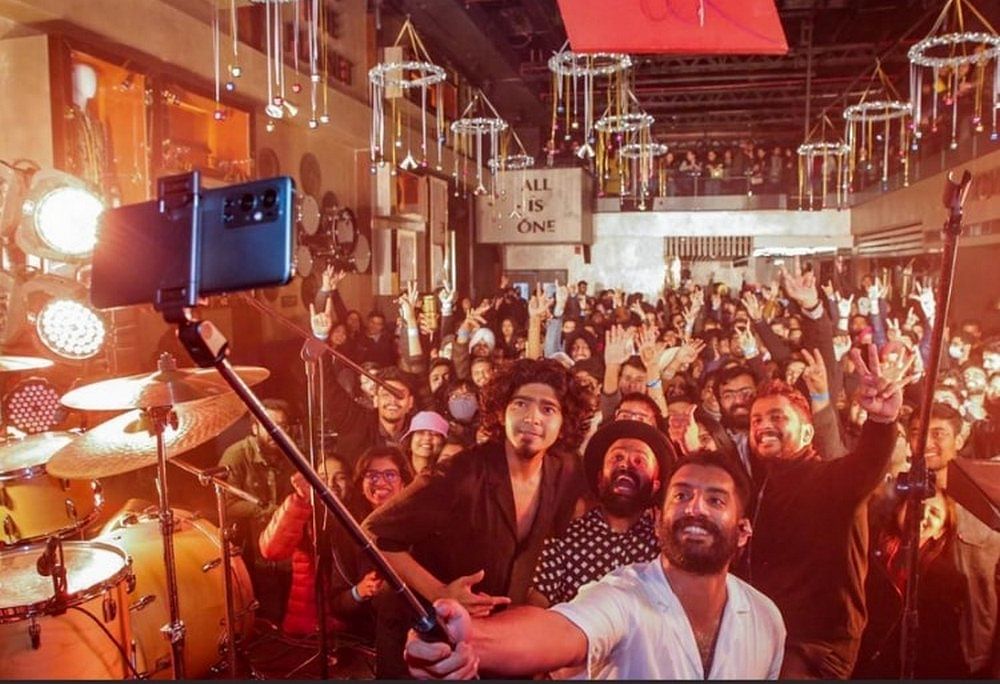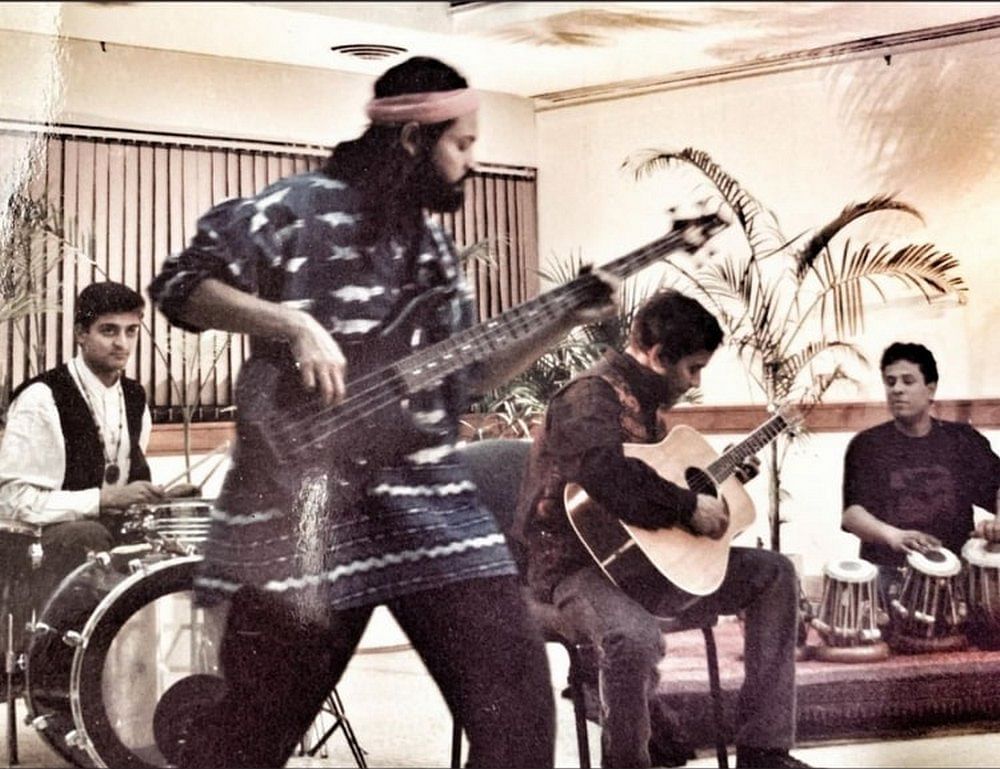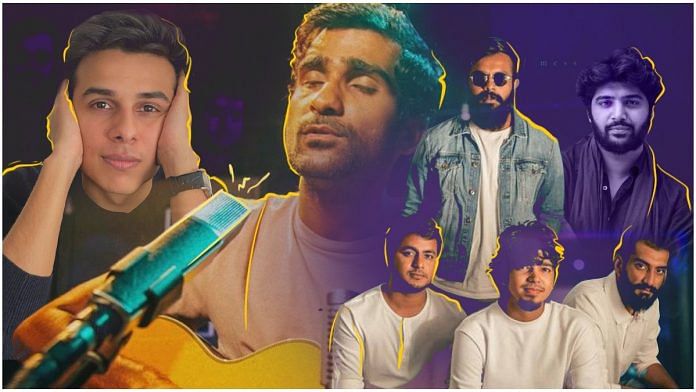“I wish Bollywood never finds this band!”
“This song is a masterpiece. Not everyone deserves to listen… just the special ones.”
“Can I just keep y’all to myself… I’m very selfish when it comes to y’all.”
For the fans who commented possessively on the 2020 video of the lyrical ‘When We Feel Young’ by the Kochi-based rock act When Chai Met Toast (WCMT), that ship has long sailed. ‘When We Feel Young’ has amassed more than 2.2 million views on YouTube and this January, the song made it to Spotify’s global Radar list (number 55 at the time of writing), which platforms promising artists from around the world. Bollywood has also come-a-calling — WCMT’s ‘Firefly’ features in the teaser of Farhan Akhtar’s upcoming film Jee Le Zaraa.
Fortunately for music fans who crave the thrill of discovery as much as they do the next catchy tune, there are plenty of other hidden gems to mine for in Instagram reels, YouTube channels, and Spotify lists. The 2020s have seen a long-overdue revival of India’s indie music scene, which since the 1990s seemed to have rolled over and given up, leaving desi playlists dominated by overproduced Bollywood hits.
The term “independent music”, or just indie, usually refers to music that is not produced under a contract with a commercial record label. In India, there is another layer of meaning: indie artists are those who create music outside the film industry, which has a monopoly on the music industry and a talent for co-opting talented new artists even if they start out independently.
For indie artists, the main source of revenue is usually live performances, ranging from small gigs at private venues to large concerts. This scene did not vanish into the sands like Lucky Ali’s solo career, but Covid restrictions put a stop to live gigs for long stretches, compelling many musicians to push more aggressively for online visibility and alternative revenue streams, contributing to a growth in their audience.

On Spotify’s Indie India playlist, a quick count shows that the top 10 independent artists cumulatively have more than 1.50 crore monthly listeners. One of the most popular among them is Prateek Kuhad, best known for the break-up ballad ‘Cold/Mess’, which somehow made it to Barack Obama’s annual list of favourite tracks in 2019 (the song was released in 2016).
Today, Kuhad has more than 19 lakh monthly listeners on Spotify. On Instagram, he has nearly 650K followers—for context, Pritam, who has been around for two decades and has several Bollywood hits under his belt, has only about 420k followers on Instagram.
Several up-and-coming artists are from small towns, like Anuv Jain, who started his YouTube channel in 2012 as a schoolboy in Ludhiana and eventually won thousands of fans with his breakthrough single ‘Barishein (Rain)’ in 2018; he has more than 500K subscribers on YouTube and more than 10 lakh listeners on Spotify. Then there are Guwahati-based Suzonn, whose soulful ‘Sun Lo Na (Please Listen)’ has an impressive 63 lakh views on YouTube, and Osho Jain from Indore.
Women singer-songwriters are still underrepresented, but promising artists slowly building up a following include Delhi-based Samahita Narang, whose soaring ‘Matwari (Devout)’ reflects Hindi classical influences, and New York-based Abhilasha Sinha who sings in both Hindi and English.
However, while people are clearly willing to listen to indie musicians, are they ready to pay for the privilege? And, what are the chances that this indie wave will survive, unlike the one in the 1990s and early 2000s?
Also Read: India ranks 20th for global music influence, 6th for uniqueness in study spanning 30 nations
Music sells… but who’s buying?
First the upside: Gen Z Indians enjoy exploration and this extends to music. A Spotify survey in 2019 found that this young set is less beholden to Bollywood than older generations, and has a taste for K-Pop and new genres. Millions of Indians are now going online to look for fresh music, and according to an Inc42 report, the music streaming market is expected to surpass $870 million by 2025. Indie music has received a major push thanks to these trends.
The effects are audible in mainstream culture. Shaadi (wedding) reels are no longer duty-bound to feature ‘Bano’ — this wedding season, the thumri-electronica track ‘Rangi Saari (Coloured Sari)’ by Kanishk Seth and Kavya Seth was all the rage. ‘Pahadon Mein (In the Hills)’ by Salman Elahi and the mellow ‘Dil Mere (My Heart)’ by Local Train are long-drive mainstays, and ‘Udd Gaye (Flew Away)’ by Ritviz is a quirky party favourite.
Yet, popular as many indie tracks are, can they help their creators make a living?
“People are going back to being OK with paying for music — this will play out quite well over the next few years,” Kishan John, manager of When Chai Met Toast, said.
However, many artists agree that their most important promotional tool is also their biggest bane: social media. The abundance of free songs on platforms like YouTube means that shelling out for music is rarely necessary.
Musicians, like Suzonn of ‘Sun Lo Na’ fame believe that social media is “a very important source of promotion”, with YouTube playing a “vital” role, but it does provide a financially viable model for artists.
“Hopefully, social media will stop playing such an important role in musicians’ career growth,” John said. “If streaming services are able to create enough pull without the help of social media, it would release a lot of unwanted tension.”
Amit Kilam, drummer and vocalist of Indian Ocean, which is often called the original Indian fusion-rock band, made a similar point: “The only downside of the social media revolution is that music has stopped selling.”
It’s a tough situation for musicians whose earnings from live concerts have dwindled sharply due to Covid restrictions on gatherings.
“The pandemic has affected us massively. Most of us (independent musicians) have been out of work. Let’s say if our main source is live shows, it has come down to less than 10 per cent or even zero in many months” Kilam said.
Himanshu Banga, who has managed artists like Suzonn and Local Train said that at one point, artists did as many as 150 college shows in a year, but this source of revenue has been “out of reach since the beginning of the pandemic”.
In this scenario, Bollywood, flush with funds, endless marketing budgets, and a readymade mass audience seems like a lucrative destination, even if signing up for a deal means relinquishing creative freedom. This is what many fans wring their hands about in the comments sections of their favourite songs: a Bollywood takeover and makeover of their beloved “undiscovered” bands. It’s happened before, after all.
Also Read: Hotstar’s ‘Get Back’ is an 8-hour journey into The Beatles. But they could’ve let it be
Whatever happened to the 90s’ indie revolution?
Independent popular music artists have worked in India since at least the ‘70s but they simply didn’t have the chance to assert their presence thanks to the audience’s attachment to film songs, according to writer Rupleena Bose, who is currently working on a book about independent artists in Bengal.
“Song and dance are a vital part of Indian cinema, which is why it is difficult to separate the two,” Bose said. In the ‘70s and ‘80s independent artists did not have the means to supplement their songs with visuals to draw in audiences, who were used to consuming music attached to a cinematic narrative. These artists, therefore, performed only for small “pockets” and could not tap into mass audiences, Bose said, adding that one of the first indie bands in India was Moheener Ghoraguli, which in the ‘70s experimented with a fusion of jazz, Bengali folk, and rock.
While the stardom of foreign bands like the Rolling Stones and Beatles slowly enabled Indian audiences to conceive of popular music as separate from the film industry, most local bands were consigned to performing covers of ‘You Can’t Always Get What You Want’ and ‘Love Me Do’ rather than their original material. There were some exceptions to this, like Remo Fernandes, who released a couple of relatively successful albums in the late 80s and whose satirical ‘Ode to Graham Bell’ was a college fest hit, but such examples were few and far between.
The big leap came in the 90s, when the advent of music channels allowed independent artists to finally leverage videos to reach mass audiences. Channel V, which started in 1994, and MTV, which arrived in India in 1996, played a major role in promoting indie-pop culture. Rock Machine, a Mumbai-based band that had been around since the early 80s, rebranded itself as Indus Creed and entranced audiences with the gorgeous ‘Pretty Child’, Euphoria became pioneers of Hindi rock and sold well, Sunita Rao’s floaty ‘Pari Hoon Main (I am an Angel)’ popped up several times a day on Channel V, and Lucky Ali crooning ‘O Sanam (O Beloved)’ had many a teen going weak in the knees.
Yet, by the early 2000s, the indie scene seemed to have gone underwater much like Silk Route’s Mohit Chauhan in the video of the 1998 hit ‘Dooba Dooba (Drowning)’. Producing and marketing music was expensive, piracy was rampant resulting in lower album sales, and for many indie artists, it was either Bollywood or bust.
Parallelly, the Indian rock scene was still picking up, with the Rock Street Journal coming of age in the late 1990s and early 2000s. It was the magazine to be spotted it. Anjan Dutta, Bhoomi, Cactus, Chandrabindoo and Fossils were enthralling several head-banging students.
But, while the vibrancy and visibility of the indie music scene did fade, Bollywood changed too, and started embracing (some might say, appropriating) new sounds and genres.
Indian Ocean, which formed in 1990, is one of the few bands to have ridden the 90s wave, experimented with Bollywood, jumped on the social media bandwagon, and has still come out more or less intact in the 2020s.

“It all started in the late 1990s when Indian Ocean was still coming up. As India started becoming a younger nation, all these things started happening, people gave (independent artists) a shot. The whole cultural landscape of India’s music changed in the ‘90s and 2000s, the industry changed. The younger people of the country are definitely looking to experiment with their musical tastes,” Amit Kilam, percussionist for Indian Ocean, said.
Indian Ocean still has a cult following, largely among older millennials and Gen Xers, and its live performances stayed sought after, but it has had limited traction on social media and streaming platforms (just over 126,000 monthly listeners on Spotify and about 27K followers on Instagram).
Nonetheless, the band has stayed relevant with its own albums (the last one, Tandanu, was released in 2014), singles like its well-received 2020 interpretation of Nusrat Fateh Ali Khan’s ‘Akhiyan Udeek Diyan (Eyes Wide Open)’, and occasional forays into Bollywood—the band provided the soundtrack for the 2015 Vicky Kaushal and Richa Chadha-starrer Masaan, with the hard-to-translate ‘Mann Kasturi’ becoming a major popular success.
Rahul Ram, bass guitarist and one of founder members of Indian Ocean, said that Bollywood has become more “open-minded”. “When I was a kid, there were fixed six singers in the film industry—four male, two female… the film industry has brought in younger, broader talents now,” he said.
Some of these “new” talents are imports from ‘90s’ indie acts. Not many in their teens or twenties would know that successful singer-composer Vishal Dadlani was once the frontman of the rock band Pentagram, which dominated the college festival circuit and released their debut album in 1996. Mohit Chauhan was the lead vocalist of Silk Route before he started winning awards for his playback singing, which has featured in movies like Rang de Basanti, Delhi-6, Fashion, and Guns of Banaras.
Yet, many independent artists are gingerly about Bollywood. Lucky Ali, for instance, publicly washed his hands off the film industry because of “disrespect” and lack of inspiration. Rahul Ram, too, has his reservations. “I would love to work with Bollywood but I wouldn’t go asking for work,” he said.
Meanwhile, the film industry seems to be starting to set its sights on new indie talents. Prateek Kuhad’s 2020 single ‘Kasoor (Fault)’, for instance, was featured in the 2021 thriller Dhamaka, starring Kartik Aaryan, and ‘Firefly’ by When Chai Met Toast plays in the background of the trailer of the forthcoming 2022 release Jee Le Zaraa.
However, this is not necessarily a sign that the new wave of indie music will vanish like the last. With adoption of paid streaming services increasing, many artists believe they can succeed without sacrificing their creative freedom. Indeed, even some Bollywood artists are going indie for just that reason.
Also Read: Coke Studio Season 14 is out and Pakistanis are gushing over Abida Parveen
Film industry artists seeking indie success
Independent artists are optimistic that streaming platforms will eventually allow them to monetise their music, even if that moment hasn’t quite arrived yet. “Streaming platforms like Spotify and Jio Saavan have literally lifted independent music,“ Suzonn said.
Further, advances in technology have made it far easier— and cheaper — for musicians to record, release, and promote their music without a record label. “There was a time when music labels had an upper hand but with ease of technology, artists have an upper hand and thus cannot be dominated,” Rahul Ram said.
Upcoming artists, like Rishabh Raguvanshi of the Delhi-based duo KhoslaRaghu, the newfound success of independent artists is inspirational. “When I look at Prateek Kuhad or Anuv Jain, their songs are recognised, as much as any Bollywood singer and it gives me a sense of relief about our future,” he said.
Even some established film industry artists seem to be getting similarly inspired. Arman Malik, known for his Bollywood albums, recently released an English-language single called ‘You’ which is trending on Apple Music. Similarly, Arijit Singh, arguably one of the biggest names in Bollywood, has started his own channel, Oriyon Music, on YouTube. The channel has about 2.2 million subscribers and occasionally features original tracks, like the well-received ‘Rihaa (Liberated)’.
What remains to be seen is whether the trend will continue and lead to what some believe is India’s chance for a global crossover, thanks to viral trends and access to international platforms, or whether there will once again be an inward tide towards either mainstream films or fringe music scenes.



